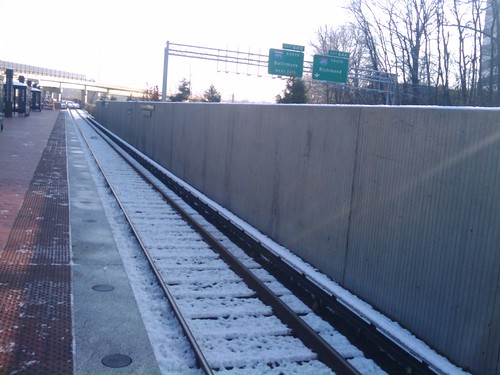
Seems like it's mostly over.
The I-66 corridor was paralyzed pretty much all week.
To sum it up:
- A major snow storm hit Friday and Saturday (starting on Feb. 5) and another on Tuesday and Wednesday (Feb. 9).
- Conditions even on the highways were reportedly quite bad at least for the first 24 hours after each storm hit. White out conditions were reported in the metropolitan region on Feb. 10. Total accumulation after the second storm was over three feet.
- Orange Line trains from East Falls Church to Vienna weren't running most of the week and most Fairfax Connector west county bus service was suspended. West county buses and western Orange Line trains ran limited service Tuesday and limited service in the afternoon Friday.
- The rest of the Metrorail and Metrobus network was running with limited service. Underground trains ran packed like sardines and with headways as long as 30 minutes. Buses provided limited service on only the most cleared roads.
- The government was closed from Friday afternoon (Feb. 5) to a delayed opening Friday (Feb. 12).
Anything I missed? Let me know in the comments.
The worst I-66 traffic jam in recent memory happened Friday morning (Feb. 12), the day the government decided to reopen, but before the aerial Orange Line or the west county bus service had been restored. The result was a huge traffic jam stretching from Route 50 in Fair Lakes to Constitution Avenue. (I traveled from Centreville to Falls Church, and the leg eastbound from Vienna to Route 7 took me nearly an hour.)
Snow is expensive. Besides costing taxpayers heaps in lost government productivity in Washington, Virginia has gone way
over its snow budget and is eating into maintenance funds. Talk about having trouble with the snowbanks.
General Assembly is in session, and a number of transportation items were in committee, including:
Redevelopment plans for a Metro-fied Tysons Corner is nearing the finals. Anyone who lives, works, or shops in Tysons or who may live, work, shop, or visit friends and family there in the future (i.e. everyone in Northern Virginia and the metropolitan area) should take note on what could become Fairfax County's "downtown."
The storm has upset some of the public meetings, so there's
still time to participate and voice support for Arlington-style smart growth, transit-oriented development, traffic calming, and urban density designed not to bring traffic but to bypass it with first-class transit, bike, and pedestrian transportation choices.
And in case you were getting disoriented with all the clear skies lately, the weather service is forecasting more snow by Monday night.









 Just before 10 am this morning on eastbound I-66 approaching the Beltway interchange, an incident brought traffic to a 15-minute standstill. Traffic reporters said a motorcade was moving through the Falls Church area and on the Beltway. People got out of their idling cars to stretch. WTOP
Just before 10 am this morning on eastbound I-66 approaching the Beltway interchange, an incident brought traffic to a 15-minute standstill. Traffic reporters said a motorcade was moving through the Falls Church area and on the Beltway. People got out of their idling cars to stretch. WTOP 

